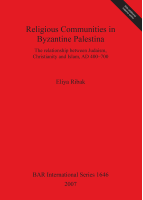Description
BOOK DESCRIPTIONThis study is an archaeological analysis of the relationship between religious communities in Byzantine Palestina (AD 400-700), based on a catalogue of excavated Byzantine sites in the region (forming an appendix to the work). After outlining the historical, archaeological and environmental contexts of the study, the identification and dating of excavated synagogues and churches are re-evaluated. This shows that, although there are clear-cut examples of Jewish and Samaritan synagogues and Christian churches, these buildings are often so similar that it is difficult to differentiate between them. It is also shown that Jewish and Christian burial practices were so similar that, unless accompanied inscriptions or symbols, the religious identity of burials is often difficult to recognize. This suggests that different communities shared similar material cultures of religious practice, probably resulting from peaceful inter-communal interaction, and highlights chronological problems in the archaeology of Byzantine Palestina. Spatial analysis of reliably identified religious buildings is then used to show that different religious communities frequently occupied the same landscapes, and even the same settlements. The credibility of using symbols on portable artefacts to indicate religious identity is assessed, and supported, by examining their association with other religious indicators. Spatial analysis of these artefacts supports the patterns already established, strengthening the interpretation that differentreligious communities lived in close proximity. This evidence is used to argue for closer and more peaceful co-existence between religious communities in Byzantine Palestina than is usually supposed. It is suggested that this relative religious harmony contributed to the economic prosperity of the region in the Byzantine period. This apparently came to an end in the late sixth or seventh century, when most excavated Byzantine sites in the region were probably disused. Although other explanations (such asplague) are possible, this widespread abandonment may be a consequence of the Persian and/or Muslim invasions. The work concludes with three extensive Appendices of sites, burials, and religious structures.











